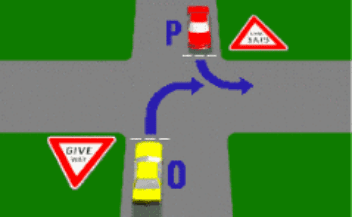Explanation:
If you are unable to cross the crossroads, you risk causing traffic congestion in the opposite direction.
Explanation:
Give way signs are placed at crossings where visibility is good enough to gauge approaching traffic, as opposed to stopping signs, which are placed at intersections with poor visibility. You must, however, be prepared to come to a stop.
Explanation:
All vehicles on the route you're turning onto must yield to you.
Explanation:
At intersections, police officers' signals take precedence over any signs or lights.
Explanation:
You'll have to wait until the junction is clear before proceeding.
Explanation:
The line's meaning is the same as the sign's.
Explanation:
At a stop sign, you must always come to a complete stop.
Advertisement
Explanation:
If a collision is imminent, pedestrians have the right of way.
Explanation:
In these instances, always be prepared to stop in case you haven't spotted the train approaching.

Explanation:
The right of way belongs to vehicle P.
Explanation:
You have the right of way over cars approaching from the left.
Explanation:
Until the next green signal, pedestrians must wait to cross.
Explanation:
At point O, you must give a signal. Always give the go-ahead to leave the roundabout after the exit before the one you are taking. If you are travelling straight over a roundabout, signal left to signify your exit rather than right.
Advertisement
Explanation:
The car is in a lane that is only for left turns or straightaways.
Explanation:
Vehicle J must make way.
Explanation:
The motorbike will be in the path of the car when it exits the roundabout.
Explanation:
Only lanes on the right or those with an arrow pointing to the right may be used to make right turns.
Explanation:
At a stop sign, you must always stop.
Explanation:
You must give way to all vehicles on the route you are turning onto.